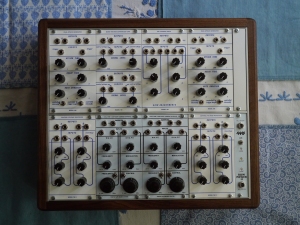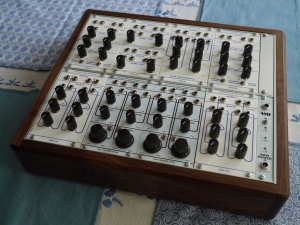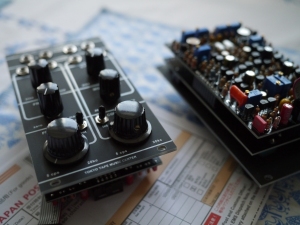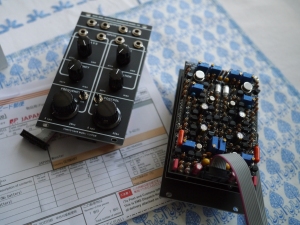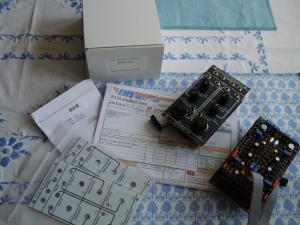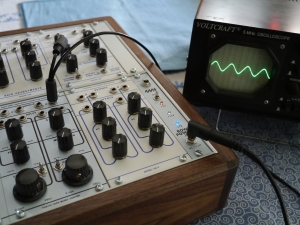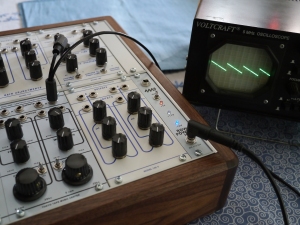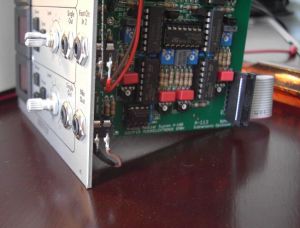Some basics
In my recent project I build a small dual filter box based on the well-known and loved Livewire Frequensteiner multimode filter, which has become a Eurorack classic over the last decades. The Frequensteiner module is based on the filter design by Steiner Parker Synthasystem from the 1970ties. It has a discrete core and is based on diodes. The filter slope is 12dB (low and high pass) and respectively 6dB (band pass).
The basic concept
I have to admit that after all the years this filter is still my all time favorite although the design is quite puristic (no V/Oct tracking, no CV of resonance, high noise floor). But the resonance sounds so very special – even with zero-resonance the filter colors the signal obviously. The filter FM is unstable and imperfect in a musical way.

The shallow 4ms 32HP Pod is used as the housing
The module has some known quirks: At high resonance turning the resonance knob will generate audible crackles, which is not caused by a mechanical issue of the potentiometer itself (some people may not like this behavior, but I like to use it as a crackle generator). The module is prone to catch audible noise and oscillations from the power bus. This can become annoying especially with digital modules and LEDs which often spoil the common ground of the modular system. I would recommend a separate power supply for the modules if you want to avoid significant signal bleeding.
Luckily, Steve R from Livewire still is still building the modules up to now, so I decided to build a very small filter box in a 4ms 32HP Pod, which is a perfect companion for very compact live sets. I decided to keep the concept as minimal as possible and omitted therefore any kind of additional modulators. The module layout is very clear. The space and the size of knobs makes it very playable, which is a very important factor for me. The box can be used for parallel (stereo) or serial (mono) filtering and doubles in function as a rather flexible sound generator. As a sound generator the spectrum reaches from pure sine to rich and wild cross-modulations.
Building a Freqbox
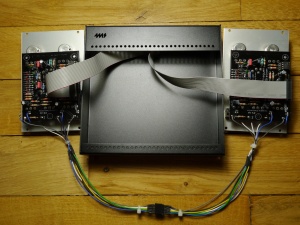
Ribbon cable with removed strain-relief at the header
The modules are build with through-hole parts which makes the modifications much more convenient. The suggested modifications make them playable without any additional patch-cords or multiples. If required, a normalization can be overruled by patching a patch-cord. In addition to the normalization the resonance behavior is fine tuned by changing two resistors. The filter becomes slightly more self-resonant, which is important to use it as a sine oscillator. However, the self-oscillation starts at approximately 12 o’clock (it does not cover low frequencies).
Normalizations (module A on the left, module B on the right hand):
- Input of module A to input of module B and vice versa
- Output of module A to CV2 input of module B and vice versa
- DC voltage to CV1 of module A
- CV1 of module A to CV2 to module B
Resonance modifications
- R12, 510 on PCB + 1k parallel = 340 Ohm in total
- R22, 10k on PCB + 10k parallel = 5k Ohm in total
Freqsounds
First example is pure Frequensteiner without changing any parameter during each recording interval. The sounds reflect the nonlinear and sometime chaotic behavior of the filter.
For the second run I added some FX and external input and modulation.
In the first examples I used the Electric Repeaters Horndog. It is based on the Ciat-Lonbarde Rolzer circuit – basically interacting nonlinear oscillators. Next a drone machine Sleepdrone 5 by Skychord Electronics is tested. It is a 4 voice drone synth with CMOS based rectangular oscillators. Finally, a rather harsh noise box called Cacophonator II by Subtle Noise Maker is used as input. The Strymon Flint gives reverberation on all examples.
0:00 – 5:13 Electric Repeater Horndog
5:13 – 7:55 Skychord Electronics Sleepdrone 5
7:55 – 8:18 Subtle Noise Maker Cacophonator II




